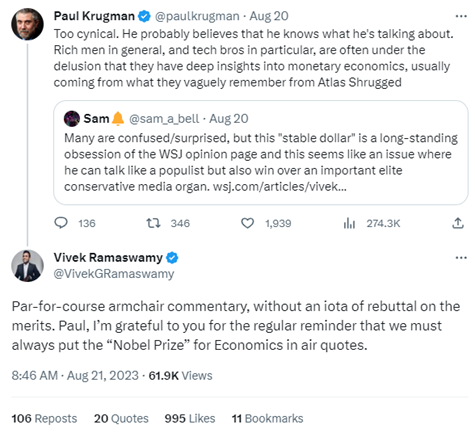Precious Metals
Why Stabilization Policy is Destabilizing
U.S. presidential candidate Vivek Ramaswamy took aim at the Federal Reserve recently:
The reality is, if the dollar is volatile, it’s as bad as if the…

U.S. presidential candidate Vivek Ramaswamy took aim at the Federal Reserve recently:
The reality is, if the dollar is volatile, it’s as bad as if the number of minutes in an hour fluctuated. None of us would be here at the same time. […] When the number of dollars [in relation] to a unit of gold or an agricultural commodity is wildly fluctuating, money doesn’t go to the right projects. It’s just wild—it doesn’t make any sense. That’s been an impediment to economic growth…
So, what we need to do as the next-step—of course I’d like to end it [the Fed]—is at least get rid of the dual mandate. We’re done managing inflation and unemployment. It’s like trying to hit two targets with one arrow, dramatically missing on both. And restore a single mandate: stabilize the US dollar as a unit of measurement against gold, silver, nickel, agriculture, and farm commodities. That’s it.
Then Paul Krugman took a swipe for no real reason.
While Ramaswamy makes some good points, especially about the Fed’s track record in achieving its dual mandate and the potential for monetary policy to cause misallocation of resources, we should recognize that his proposal is nothing but the old stabilization policy idea, this time in populist clothing.
In short, there’s no reason to consider money as a yardstick. We should think about money as a good in its own right, subject to changing demands over a changing supply. I think the people who use the “money as a yardstick” argument realize that prices aren’t arbitrary numbers. But if we manipulate the supply of dollars in an attempt to stabilize the price of a basket of Ramaswamy’s chosen goods, then we reject the importance of allowing prices to change. We substitute the coordinative process by which entrepreneurs arrange production for the sake of consumers’ wants and needs with an arbitrary rule (stable prices) based on an arbitrary basket (in Ramaswamy’s case: gold, silver, nickel, and agricultural commodities, which is itself an arbitrary basket).
It’s alright for the purchasing power of money to change, especially in a commodity standard, because we live in a world of change. If people decide to accumulate more money by selling more and by buying less, then prices will decrease accordingly and simultaneously, which is to say the “purchasing power” or value of money will increase just enough to balance out the increased demand for money. As prices decrease, the opportunity cost of holding money increases, so there’s no reason to fear this process getting out of control. The same dynamic applies to any other good, say used cars. If the demand for used cars increases, their prices will increase as a result, and the process of buying and selling used cars ends with the stock of used cars in the driveways of those who have relatively higher demand.
Now, imagine what would happen if the demand for one of the goods in Ramaswamy’s basket increases. Suppose carrots are a part of the agricultural commodities sub-basket and that the demand for carrots increases. Normally, we’d see increased prices offered by consumers and corresponding alterations to production. Fewer factors of production would go toward other goods and more would go toward carrot farming. But if we try to stabilize the price of carrots, it arrests that consumer-directed process. The stock of carrots won’t be economized, and production won’t be shifted accordingly. We’d have a stable carrot price, but it would come at the cost of the market process that coordinates supply and demand.
However, the preceding example assumes that the policy goals are achievable. In practice it would be very difficult to expand and contract the money supply, which can be spent on all sorts of things, to target the price of a particular basket of goods. It would be even more difficult to do so without terrible unintended consequences. If, for example, we retain the traditional channels of monetary policy and increase the supply of money through credit markets, then we risk starting business cycles all for the sake of keeping the price tag of carrots the same. But even if other channels are used, like direct checks to consumers, there’s no way to guarantee that consumers will spend the new money in a way that will achieve the policymaker’s goal of stabilizing the price of the chosen basket.
This is not to say that Paul Krugman was right (heaven forbid). He just wants the Fed to have the discretion it needs to impose a Krugman-flavored policy, meaning he wants people he likes in charge of monetary policy. Krugman wants arbitrary rulers while Ramaswamy wants arbitrary rules.
While there’s probably a good debate to be had over whether rules or discretion makes for better monetary policy, the best policy is no policy. Arbitrary rules and arbitrary rulers are both arbitrary. The only rational, nonarbitrary way forward is to leave money production to the market.
dollar
gold
silver
inflation
commodities
commodity
monetary
markets
reserve
policy
money supply
fed
us dollar
monetary policy
aim
nickel

Canadian Silver Co. Will See Big Changes in 2024
Source: Michael Ballanger 12/22/2023
Michael Ballanger of GGM Advisory Inc. takes a look at the current state of the market and shares on stock…
EGR options out Urban Berry project in Quebec to Harvest Gold – Richard Mills
2023.12.23
EGR Exploration Ltd. (TSXV: EGR) has moved from owner to shareholder at its Urban Berry project in Quebec, this week announcing it is optioning…
Crypto, Crude, & Crap Stocks Rally As Yield Curve Steepens, Rate-Cut Hopes Soar
Crypto, Crude, & Crap Stocks Rally As Yield Curve Steepens, Rate-Cut Hopes Soar
A weird week of macro data – strong jobless claims but…












